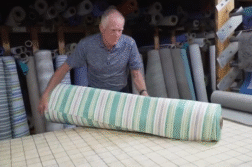CHICAGO. (Ivanhoe Newswire) — After nearly a decade working in the healthcare industry, Liz Yerly realized that the hours after a workout were just as crucial as the workout itself and she built an entire business around it. But even if you don’t have access to her kind of state-of-the art equipment, Yerly has some tips for the everyday athlete on how to train like a pro and recover like a pro.
Five mornings a week, the mantra for 32-year-old Caitlin Carducci is run faster. She wants to qualify for the Boston Marathon.
“Oh, the soreness. You’re sore, you’re stiff, muscles that you don’t think you use while you’re running somehow still hurt when you wake up the next day,” detailed Carducci.
Which is why she recovers just as hard as she trains.
“It makes a huge difference in your ability to recover, come back and get back out the next day,” Carducci told Ivanhoe.
Liz Yerly, MPT, ATC, owner of Chicago Recovery Room, said, “We kind of say train like a pro, recover like a pro. We wanted to bring that to the everyday person.”
Yerly’s Chicago Recovery Room features leg compressors that flush toxins from athletes’ muscles and 12 minutes in the 52-degree ice bath works as a natural anti-inflammatory.
“If you come in here with ten miles on your legs you leave feeling like maybe there’s two on them,” said Carducci.
Yerly told Ivanhoe, “They can feel like they can work out harder sooner. So they can do more intense workouts quicker.”
But if you don’t have access to a recovery room like Yerly’s, she said there are things people can do at home. Like make your own ice bath, or do a self-massage.
“Certain recovery tools are really easy to have so foam rollers or lacrosse balls; some every day products you can use to do your own self-massage,” explained Yerly.
But Yerly said recovery doesn’t mean falling into the couch for 24 hours, especially the day after a tough workout.
She said, “It can definitely be just going for a walk, getting on a bike, going for a swim. So you want to do something that’s going to keep your body moving so you don’t have a chance to get stiff, or have some of the metabolites or toxins that build up during a workout settle.”
After Carducci put more emphasis on recovery, she improved her best marathon finishing time by a whopping 33 minutes.
Contributors to this news report include: Jessica Sanchez, Field Producer; Roque Correa, Editor; Tony D’Astoli, Videographer.
TRAIN HARD, RECOVER HARDER
REPORT #2369
BACKGROUND: Believe it or not, muscles grow after you leave the gym. When you lift heavy weights, your muscles are actually tearing and are broken down by a process called catabolism. After you leave the gym, the recovery process starts immediately. But there are things you can do to help speed this process up and assist your muscles, like eating potassium for example. Use of high-tech machines, like the ones in the Chicago Recovery Room, can be a great way to recover fast.
(Source: http://www.bodybuilding.com/content/8-ways-to-maximize-your-post-workout-recovery.html)
CHICAGO RECOVERY ROOM: The Chicago Recovery room is open to the public and takes walk-ins. Their equipment includes:
Muscle stimulation: stimulates the muscles to reduce swelling.
Ice bath: Ice baths have proven to shorten injury recovery times, help remove lactic acid, reduce swelling and normalize adrenaline production in order for the body to recover fast from intense workouts and training sessions.
Compression boots: This ‘boot’ mimics the muscle pumps of the legs, hips and arms and enhances the movement of fluid and metabolites out of the limbs.
Cold laser: The Recovery Room says, this machine “sends small amounts of electrical current to the cells which promotes the production of ATP (the cell’s energy molecule) and protein, as well as assists in the absorption of nutrients and the elimination of wastes.”
Ice pack therapy: Cryotherapy constricts the blood vessels and slows down the metabolism of these cells and decreases inflammation.
Heat pack therapy: Heat decreases the stiffness in joints, reduces pain and helps avoid muscle spasms by increasing blood flow to the cells
Other therapeutic tools: including foam roller, balance boards, BOSU trainers and more.
For more information you can go to www.chicagorecoveryroom.com.
NINE AT-HOME WAYS TO RECOVER: Not everyone has access to these high-tech machines. Lifehack.org has a few ways you can speed up recovery time at-home.
- Hydrate to help your body flush out toxins.
- Drink a protein shake. Research has shown protein shakes, before or after workouts, greatly reduces soreness.
- Apply muscle creams, like IcyHot.
- Take anti-inflammatory drugs, like Aspirin.
- Ice your body (or make your own ice bath!).
- Stretch.
- Drink chocolate milk (to make a healthy version mix milk, raw cocoa powder and honey).
- Eat a high-protein meal (meats, eggs or yogurt).
- Drink cherry juice.
(Source: http://www.lifehack.org/articles/lifestyle/12-proven-ways-speed-muscle-recovery.html)
* For More Information, Contact:
Liz Yerly, MPT, ATC, LMT, CSCS
312-952-1404
Free weekly e-mail on Medical Breakthroughs from Ivanhoe. To sign up: http://www.ivanhoe.com/ftk



